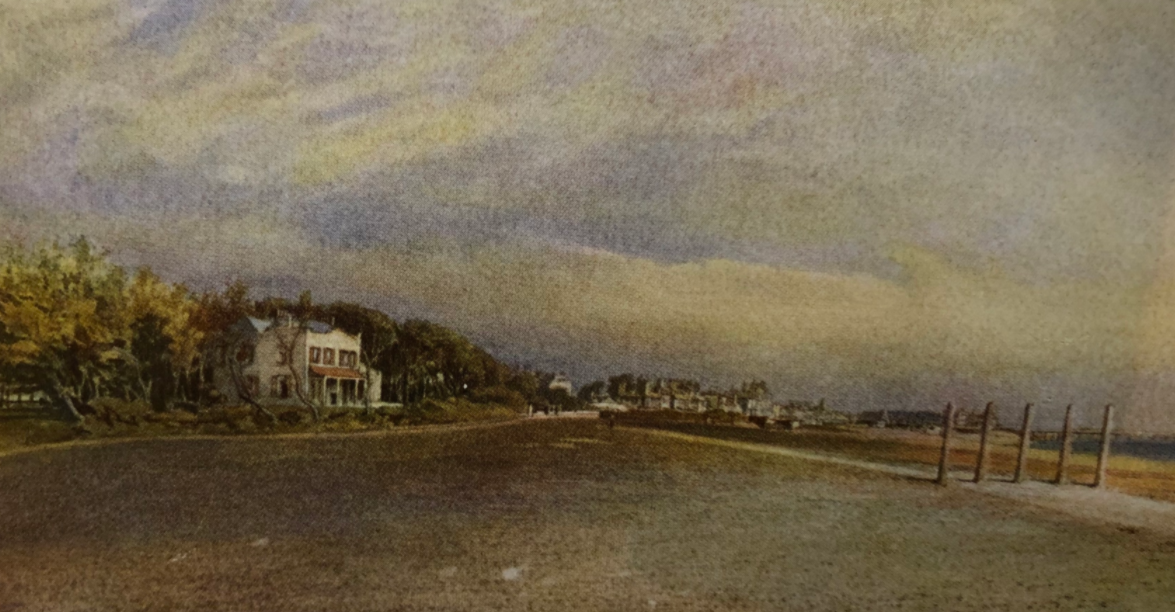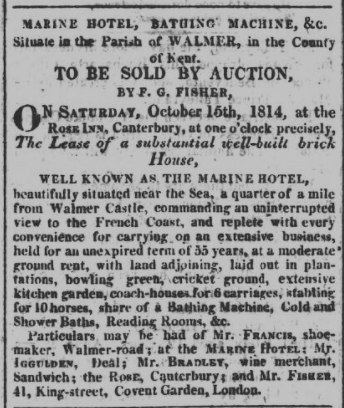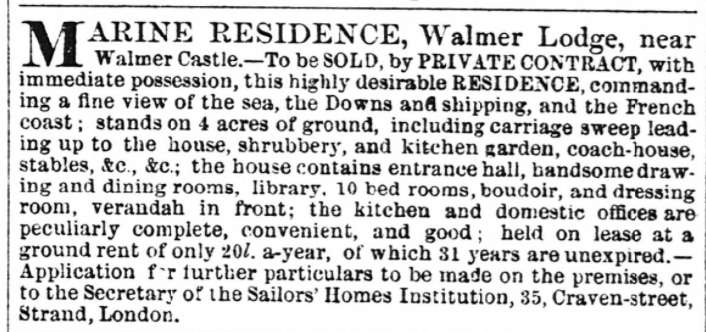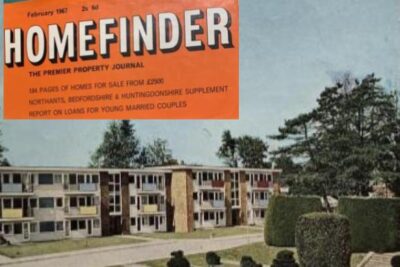Follow us on Facebook @FHofDW
Lucy Hill
Falmouth, Cornwall
Deptford Naval Yard
Walmer Lodge, Walmer
22 The Beach, Walmer
Hillside, College Road, Wolborough, Devon
Occupation: Daughter of Naval Officer
Our research into Lucy Hill started with a letter that we found on ebay. It was sent to Lucy from her father’s solicitor in 1855, a Mr. Meyhill. The correspondence stated that once, ‘ the April dividends were paid, the bank book made up and sent to her father’s bank’, they could then finalise and close the account.
But who was Lucy? Who was her father, and why such a letter? The only clues we had were Lucy’s name and address.
So the research began. We discovered that her father was Rear Admiral Sir John Hill. He died, aged eighty-one, in January 1854 at Walmer Lodge. Presumably then, once Mr. Meyhill had closed the account, the financial affairs of Sir John, and at £80,000 they were substantial, would then be in order so giving Lucy her brother John and a family friend, as executors to Sir John’s will, the ability to finalise his wishes. According to The National Archives Currency Converter £80,000 was worth, in 2017, £6,414,888.00.
Sir John Hill
Sir John had had a long and distinguished naval career serving in the American War of Independence, the French Revolutionary and the Napoleonic Wars. He served on HMS Minotaur at the Battle of The Nile in 1798 and was later in charge of transporting troops prior to the Battle of Waterloo. After the conflict he remained in Europe for several years where he supervised the transport of troops, wounded soldiers, and prisoners of war. In 1820 he was made Captain-Superintendent of Deptford Victualling Yard where in 1838 he oversaw the preparation for the sale and disposal of HMS Temeraire.
During the 1830s, the then Captain John Hill, oversaw the relief granted by Parliament, for the famine in Ireland and then in Scotland. Lucy later describes her father as being “…employed on three special missions to Ireland and Scotland under the Treasury and on several secret and confidential services under the Admiralty…” . He was knighted by King William IV in 1831 and also gained the “.. approbation of HM Queen Victoria on his return for a special mission to Scotand in 1837…”
Lucy Hill
Lucy was born in 1807 the third child of the then Commander John Hill, and was named Lucy after her mother. She had two sisters, Eliza Anne and Emma and a brother named John Thomas. She never married and like most women of her time, Lucy lived her life in the shadow of her male relatives. She, it seems, rather than her mother or even her elder sister became her father’s companion at official events. He must have had faith in her by making her an executrix to his will.
Eliza Anne Hill
Eliza Anne seems to have been born before her parents’ marriage. She was, according to the Falmouth parish transcripts, baptised in 1808, at the same time as her younger sister Lucy. The transcript gives her date of birth as August 3, 1803, her parents though, did not marry until 1804.
Eliza Anne remained a spinster living with her parents until their deaths in Walmer Lodge which is where she too died in 1878.
Emma Hill
Little is known about Emma, except that she was born in November 1805 and later married Royal Naval Captain William Langford Castle in 1835 but she sadly died two years later leaving no children.
John Thomas Hill
John Thomas Hill was born in 1811. He married twice, first to Frances Scobell, known as Fanny, in 1836 and had four children, three sons John Edwin Dickson, Charles Roche and Arthur Manley, and a daughter Frances who sadly died a few months after she was born. Fanny died in 1865. John Thomas married again in 1875 to Emma Wills, nee Bracewell, who was a twenty-seven-year-old widow.They had two daughters Elizabeth and Blanche.
John Thomas rose to the rank of General in the Army and died in Wolborough Devon in 1902. His sons were also to follow him into a military career.
Dame Lucy Hill
Their mother, Lucy Barrett, née Swinburn, was a widow when she married Commander John Hill in St. Pancras on April 7, 1804. It is unclear where or when her first husband Joseph Francis Sill Barrett died but we know he was the son of Wisdom Barrett who derived his wealth from the sugar and rum produced on his Jamaican Estate, Spot Valley.
Wisdom Barrett himself died in his London home in 1798 leaving his estate to his children Samuel, Mary and Joseph. In his will he left Joseph a life annuity of £1,000, and Wisdom had the forethought to provide for his daughters in law, should they become widows. The provision he made for Lucy stated “…In case my son should leave a widow, an annuity of £200 p/a to her, to be paid out of the £1,000 annuity…”.
It has to be said that at this time slavery was still legal and Spot Valley in 1800 had 243 enslaved people living and working on the estate.
In the United Kingdom in 1807, an act was passed making it illegal to purchase slaves directly from the African continent. Nevertheless, the practice of slavery remained widespread and legal in the British Caribbean. On 28th August 1833 The Slavery Abolition Act finally received Royal Assent meaning after years of campaigning the injustices of slavery would soon come to an end. The law took effect on 1st August 1834. Following the Slave Compensation Act of 1837 the British Government set aside a fund of £20 million pounds to compensate the slave owners. A total of 40,000 claims were paid out.
We know that on Spot Valley, in 1832 there were still 171 enslaved people, and that Sir John tried to claim compensation for the loss of the enslaved people on Spot Valley on behalf of his wife based on her annuity of £200 p.a. Presumably with the loss of the slaves the estates income would be depleted and so Lucy would no longer receive her entiltelment. Though it seems that it was already £1,000 in arrears and Sir John, on behalf of Lucy, had already been involved with litigation between himself and others, namely Samuel Wisdom Barrett , Lucy’s brother in law since at least 1808, in regards to Wisdom’s will.
The claim though was unsuccessful.
The King’s Birthday
It seems that Dame Lucy may have preferred a quiet life. She is not reported as attending the official functions both of business or pleasure that her husband was expected to attend. Instead, it was their daughters who accompanied him.
In 1834 the family were invited to a ball, held at St. James’ Palace, to celebrate William 1V’s birthday. All those who attended were listed on over three pages of the national and local papers. Just as in today’s media it was the ladies gowns that attracted attention and were described in the newspapers. From this report we know that all three sisters wore identical outfits. The ‘Miss Hill’ refers to Eliza Anne. Dame Lucy though is not mentioned.
The 1841 census tells us that Sir John was still living in the Naval Yard at Deptford where he was the Superintendent. Dame Lucy, Eliza Anne, and Lucy are also in residence as were two female and two male servants.
Deptford was a busy naval victualling and shipbuilding yard and it was during Sir John’s residency that Lucy launched two of the new steam ships; HMS Porcupine, in 1844, and in the following year HMS Terrible.
In 1851 Sir John retired and settled into life at Walmer where he became the last Captain of Sandown Castle. The Castle by then was already succumbing to the ravages of the sea. In 1863 the material of the castle was sold by the war office and the following year the upper levels were demolished. Further demolition work took place in 1882 and most of the surviving stonework was destroyed in 1893.
Perhaps it was his association with Lord Wellesley, later the Duke of Wellington, that had brought Sir John to lease Walmer Lodge which was situated on the beach quite near to Walmer Castle. Without access to the original lease documents, we don’t know when Sir John bought the lease or from whom.
It is possible that the property was originally built as the Marine Hotel which was put up for sale in 1814. In 1819 a Mrs Hill subscribed to alterations to old St Marys so it is possible that Sir John had already purchased the property making it their holiday then retirement home. Of course this may be another Mrs Hill.
In 1854 Sir John was invited to an Easter event held at The Mansion House in London. Again It seems that it was his daughters, Lucy and Eliza Anne, who accompanied him. This makes us think that maybe Dame Lucy was an invalid and was unable to be at her husband’s side.
Sadly Sir John died in January the following year. He was buried in St. Mary’s Church Walmer.
Sir John’s obituary in the national newspapers obviously focuses on his naval career, and no mention is made of his funeral or grieving family except that of his son “… who is a Captain in the army..” and a daughter, who we know to be Emma as “… the wife of the present Captain W L Castle R.N….”
As per Sir John’s instructions, the lease to Walmer Lodge was put up for sale, but who bought it, if it actually was sold, is unknown. What is known though, is that Dame Lucy died there in 1862, in her ninety-seventh year. She was buried on September 9th in St. Mary’s Church-yard Walmer in the family vault alongside her husband.
Lucy and brother Major General John Thomas were executors for their mothers will. In which she leaves all her estate equally between her three surviving children and provides for her grandchildren. However, much of the will is taken up with her inheritance derived from the will of Wisdom Barrett and Spot Valley. It seems that she was still waiting for her entitlement as the will states “…under the will of Wisdom Barrett esq… all arrears of such annuities and other monies ….when and as the said sums of monies and funds shall be received…” Dame Lucy was wanting to use this money to set up a trust fund for her grandchildren. It seems unlikely that this money was ever retrieved.

‘A Terrible Shipwreck: 12th February 1870 at Kingsdown near Deal’ by Thomas Longley Mourilyan In the Compton Verney Collection
Then on February 9 1870 a great storm brought several vessels crashing on to the beach. One vessel ‘Eglantine’ came ashore opposite Walmer Lodge where, according to Charles Elvin in his book The History of Walmer and Walmer Castle, was the residence of ‘Miss Hill.’ We believe this must be Eliza Anne as Lucy is usually referred to as Lucy Hill and was by that time living at 22 The Beach. A near neighbour of hers Captain Douglas was one of those many local men who helped rescue the crews from the stricken vessels.
Eliza Anne remained at Walmer Lodge until her death in 1878 she was buried in St. Mary’s Church-yard, Walmer on November 23rd.
In 1879 as requested in Eliza Anne’s will her executors put the lease of Walmer Lodge up for sale. She left her estate of £20,000 and her personal belongings to her nephews and their families.
Walmer Lodge was then purchased by a Mr Tod who in turn sold it in 1902 to a Dutchman, Albert Oochs. He then demolished Walmer Lodge and built Walmer Place this was later to become the holiday home of Agnes Mark Wood. Walmer Place was later itself demolished and modern flats.
In 1883 Lucy made one last tribute to her father by donating £300 towards the building of the North Deal Boatmen’s Rooms. This was to be completed the following year and in part built of the stone from Sandown Castle. A plaque was eventually placed in the rooms.
Old St. Mary’s Church or the Church of the Blessed St.Mary the Virgin had become far too small for the growing congregation of Walmer so it was decided to build a new larger church. St. Marys the Virgin was consecrated in 1888. This was built by subscription, and Lucy contributed £10. Another £10 contribution is attributed to ‘The late Miss Hills’ this must be from Eliza Annes estate; a further £20 was donated by their brother, General Hill.
Perhaps it was the death of her sister in 1878, the last member of her family in Walmer, that prompted Lucy to move. She retired to Newton Abbot in Devon staying at first with her brother. She later died in her own home, aptly named Hillside, in Wolborough, Newton Abbot in 1891. In her will she left just over £20,000 to her nephews.
Her brother General John Thomas Hill died, aged ninety-one, in 1902. Although he had a long and illustrious military career himself, he too seems to have lived in his fathers shadow.











